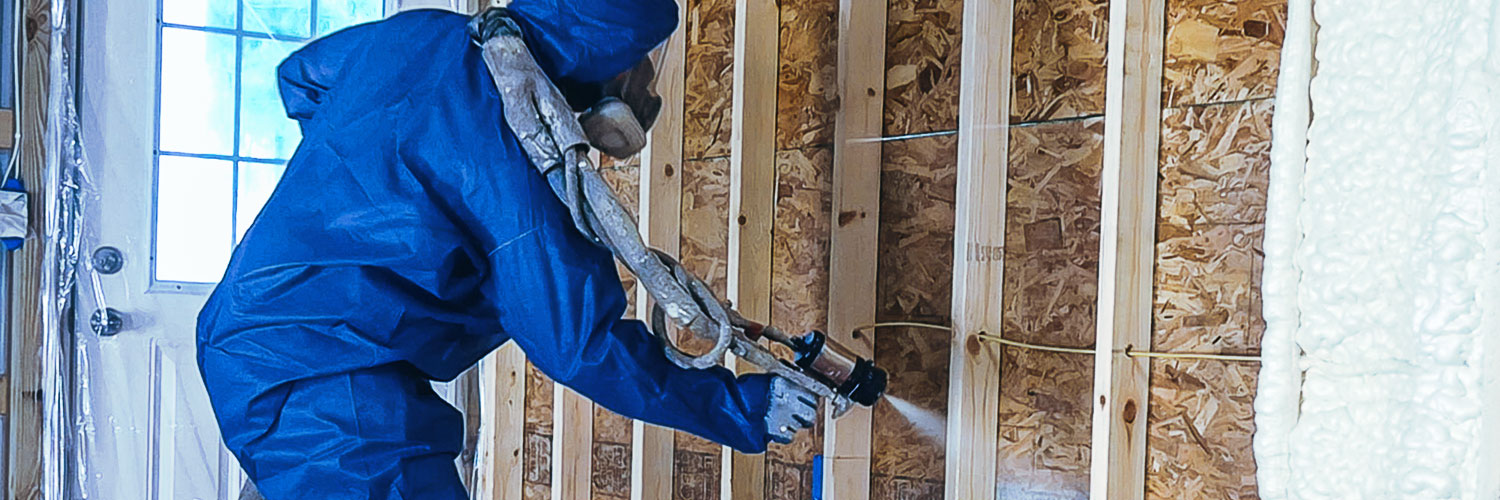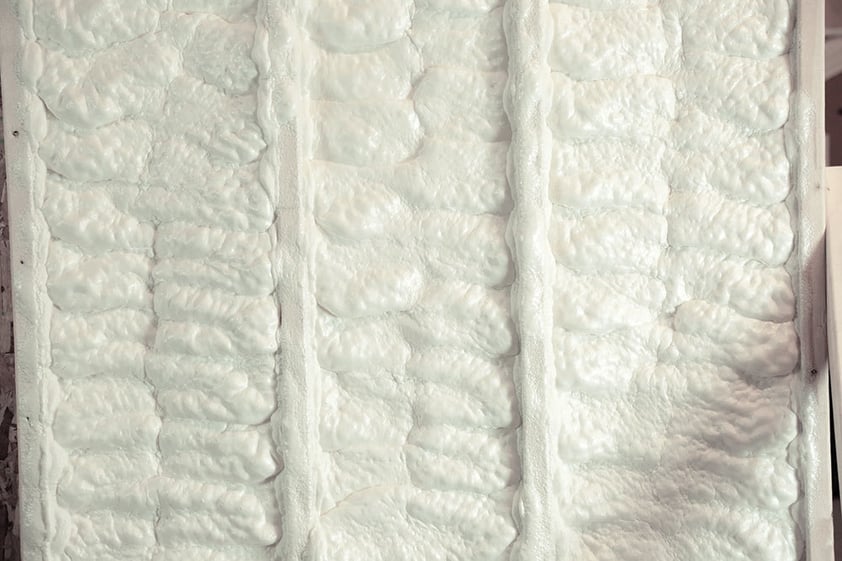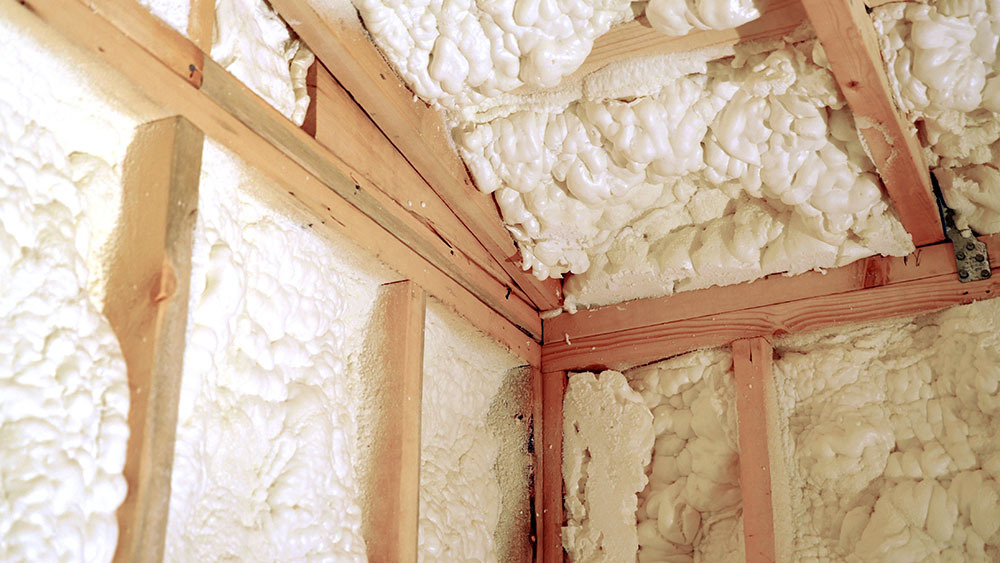What is Spray Foam Insulation?


In your research endeavors, you’ve likely been reading a lot about spray foam insulation, but what is it exactly?
Not only aren’t you sure what the material is, but how and where is it installed? What is foam insulation made of?
There are a lot of questions you might have but don’t worry, we have the answers. While RetroFoam specializes in injection foam insulation, many of our dealers also offer spray foam to seal the entire building envelope in the home.
We’ll talk more about that air seal in just a moment. In the meantime, we’ll get into the spray foam insulation definition and how it works.
What is Spray Foam Insulation?
Spray foam insulation is a material that creates an air barrier in exposed wall cavities, attics, crawl spaces, and rim joists.
It is also a great insulation to use around electrical boxes, light fixtures, and where the walls of a home meet the windows and doors.
Spray foam is used in existing homes, new build homes, commercial buildings, and pole barns. Spray foam insulation application can take place as long as the cavities are open and there is access.
One of the reasons homeowners choose spray foam insulation, much like injection foam, is because the material never loses its shape, like fiberglass. It also never shifts or settles, like cellulose.
Spray foam insulation fills all of the cracks, gaps, and crevices where it is installed.
Why Use Spray Foam Insulation?
Spray foam insulation, much like injection foam, is a superior product with several benefits to the homeowner or contractor.
Here are the benefits of spray foam insulation.
Lower Energy Bills
Dealing with high energy bills every month can be a real bummer.
This happens year-round because your furnace and air conditioner are running constantly in an attempt to maintain a constant temperature. The air seal created by spray foam insulation in the attic, crawl space, and rim joist can help lower those bills, especially if you also choose to insulate your existing walls with injection foam.
The air seal created by foam insulation seals the building envelope when used throughout the home. This makes it impossible for air to leak into and out of your home.
Give Your Furnace and AC Unit a Break
The air seal created by spray foam insulation stops air leaks, which means the furnace and AC unit won’t have to run constantly to keep up.
By giving those appliances a break, they won’t have to receive extra maintenance or burnout before their time.
Stop Drafts from Getting Inside
Drafts around the floorboards, drafts around the windows and doors, and drafts throughout the whole house.
Spray foam will stop those drafts coming in through the rim joist, crawl space, and around doors and windows. The air seal created by spray foam insulation stops drafts dead in their tracks.
An added benefit of spray foam is that it gets into all of the nooks, crannies, and gaps where it is applied. Creating an air barrier in those hard-to-reach places stops those sneaky leaks.
Stop the Formation of Ice Dams
Ice dams can be dangerous and very bad for the roof of a home, depending on their size.
Ice dams form when melted snow freezes on the roof and the heat loss from the attic melts it. That water then runs down the roof creating ice dams at the end of the roof at the gutters.
Because spray foam insulation creates an air seal, it prevents heat from escaping through the roof. The air you pay to heat circulates through the home, heading to the attic. Using spray foam insulation on the roof deck will prevent the air from escaping through the roof.
How Does Spray Foam Insulation Work?
Spray foam insulation can dampen the sound coming into the home and out of the pole barn.
It also deters the growth of mold and mildew and reduces airflow while stopping drafts and cold floors. As we discussed above, it also helps lower monthly energy bills.
Spray foam insulation impacts the conduction (heat transfer) and convection (airflow). These two things affect a home’s comfort and energy efficiency. The job of insulation is to resist heat flow into or out of a space. Insulation keeps a home warm in the winter and cool in the summer.
When comparing spray foam insulation to materials like fiberglass and cellulose, it’s best to think of it as wearing a sweater or a windbreaker.
A sweater on a cold day is nice, warm, and cozy, but it won’t keep you warm if the frigid wind is blowing right through it.
A windbreaker is much more comfortable and effective at blocking the cold wind.
The sweater is fiberglass and cellulose, while the windbreaker is spray foam insulation.
Air leakage is a real issue in many homes as it contributes to its energy loss and comfort issues. Some homes leak enough air each day to fill two blimps, so imagine what that does to a home’s comfort and energy efficiency.
Some spray foam insulation can expand up to 100 times its original size, so it gets into all of the little crevices to stop air leakage. Fiberglass and cellulose can’t fill those small gaps the way spray foam does.
What is the Difference Between Closed Cell and Open Cell Spray Foam?
When choosing spray foam insulation for your project, you have two options -- open cell spray foam and closed cell spray foam.
Both of these spray foams create an air seal, but some differences may be a better fit for one project over another.
Closed Cell Spray Foam Insulation

Closed cell spray foam insulation is a spray-applied plastic used most commonly in pole barns, commercial structures, and vans.
This is because the closed cell spray foam is a very durable and dense material. The material can be left exposed because it won’t get damaged if it gets bumped and hit.
Closed cell spray foam isn’t the best option for residential projects, but there are instances when it is the better choice, especially if the home has limited space.
Here are some of the benefits of closed cell spray foam insulation.
- Because closed cell spray foam is durable, it can be left exposed without worrying about damaging the foam.
- Water can’t pass through the closed cell foam, but with that being said, it shouldn’t be used to fix leaks in the structure.
- Closed cell spray foam limits air leakage where it is installed.
- Closed cell doesn’t have a high expansion rate, so it is the best choice for smaller projects like cargo vans and tiny homes.
Open Cell Spray Foam Insulation

Open cell spray foam insulation is sprayed into any open cavities, including open walls, attics, crawl spaces, and rim joists.
Much like closed cell spray foam, open cell creates an air seal where it is installed. It can be used in existing homes, new build homes, and pole barns. Open cell foam is much more pliable than closed cell and can expand up to 100 times to fill all of the nooks, crannies, and crevices where it is installed.
Because open cell spray foam is a softer material, it can’t be left exposed like closed cell can.
Here are the benefits of open cell spray foam insulation.
- Open cell is a less expensive option when compared to closed cell.
- Because open cell spray foam is pliable, when your home shifts and settles, the spray foam moves with the structure, so it doesn’t break or pull away from the studs.
- Open cell spray foam does allow water to move through it but doesn’t retain the moisture.
- Open cell spray foam can help make your home quieter with its sound dampening qualities.
What is Spray Foam Insulation Made Of?
Every spray foam manufacturer will use different materials to make their foam, as well as different blowing agents which are either water-based or chemical-based.
Typically, when most spray foams are made, two liquids are combined, causing a chemical reaction that forms the spray polyurethane foam. These two liquids come in two different containers, usually referred to as the “A” side and the “B” side.
The “A” side of spray polyurethane is usually made of methylene diphenyl diisocyanate and polymeric methylene diphenyl diisocyanate. The “B” side is usually a blend of polyols, catalysts, blowing agent, flame retardant, and surfactants.
When “A” and “B” meet, the chemical reaction creates the spray foam.
Is Spray Foam Safe for My Insulation Project?
If you’ve researched spray foam insulation on the internet, you’ve likely read some horror stories that make you question whether it is safe.
Not all spray foams are alike and aren’t of the same quality.
Spray foam insulation does have some off-gassing, but the amount will vary depending on the product. There are some health concerns surrounding off-gassing and odor, but those concerns really only come into play when it happens in large amounts.
If this off-gassing is a concern for you, make sure the product that will be used for your project has low-VOCs and a lower re-occupancy time of around 2 hours.
How is Spray Foam Insulation Installed?
When spray foam is installed in an existing home, the first thing to be done is to remove any old insulation from the area.
This is done because the spray foam needs a clean place to adhere to. There won’t be any removal if the installation is at a new build home, pole barn, or commercial structure.
When installers arrive the day of the installation, they will prep the area where the foam will be sprayed. The kind of preparation really depends on where the spray foam is applied.
If the basement rim joist is being sprayed and there are items down there, they need to be moved and covered with plastic before the installation takes place.
Once all of the prep work is done, the installer will run the spray foam hose to the area to be sprayed and get to work. When they are finished, the cleanup begins.
Is Spray Foam an Energy Efficient Insulation?
The average American spends $2,000 on energy costs, and about $200 to $400 of that is going to waste because of air leaks, according to the U.S. Department of Energy.
That is the equivalent of leaving a window open in a home all day and all year long.
The air seal created by spray foam insulation prevents that air leakage, making the home more comfortable and energy-efficient.
Sealing Your Building Envelope with Spray Foam and Injection Foam Insulation
If you want to make your home more comfortable year-round and save yourself some money on your heating and cooling costs, sealing your building envelope is the way to go.
Using injection foam insulation in your existing walls and spray foam in the attic, crawl space, and rim joist will seal up your home, preventing any air leaks into or out of the house.
If you want to learn more about the benefits of foam insulation, check out the Learning Center on our website.
Related Articles
What is the Difference Between RetroFoam Injection Foam and Spray Foam Insulation?
Is RetroFoam Safe to Have in Your Home?
Fishing Electrical Wire Through Insulated Walls with RetroFoam
About Amanda Emery
Amanda previously has worked as a breaking news and crime reporter, TV news producer, and editor. As a journalist, she has won several awards from The Society of Professional Journalists - Detroit Chapter and the Michigan Press Association. Amanda uses her experience as a journalist to write content that will help educate homeowners on foam insulation benefits. When Amanda isn’t writing, she’s spending time with her husband Chris, daughter Lilith-Maeve, and rescued huskies Danger and Wendigo. She also loves knitting, making art, and cooking.


